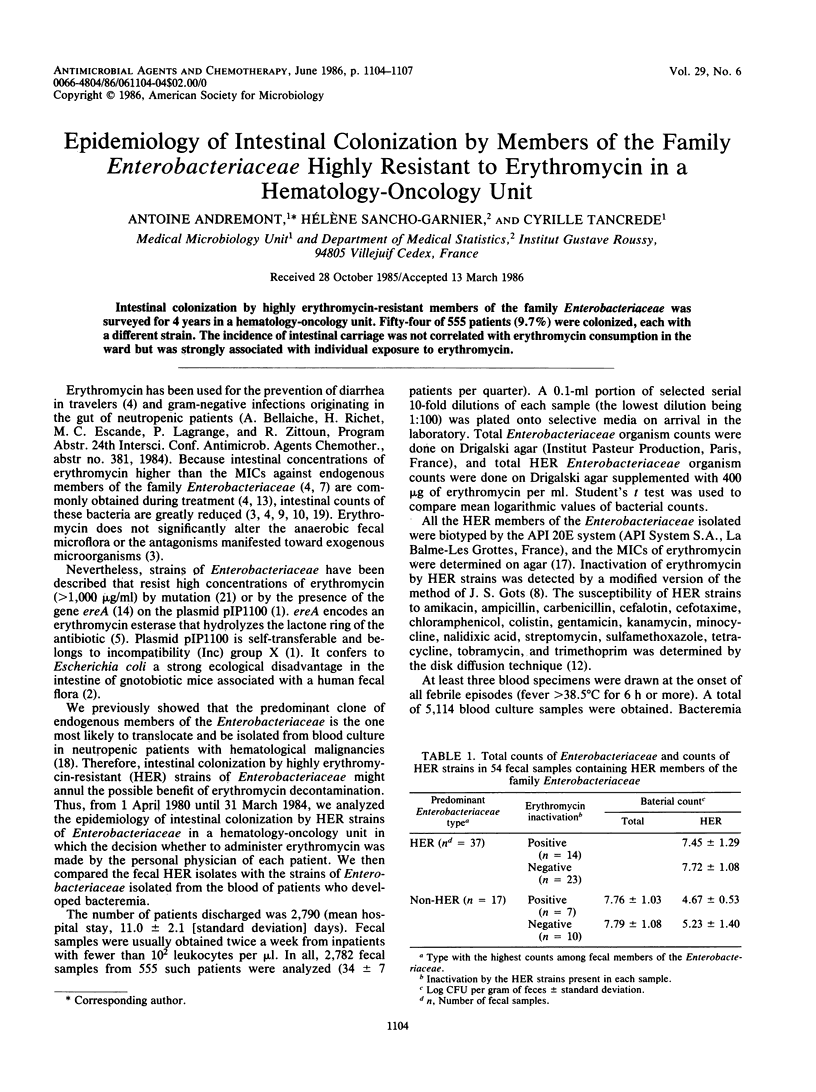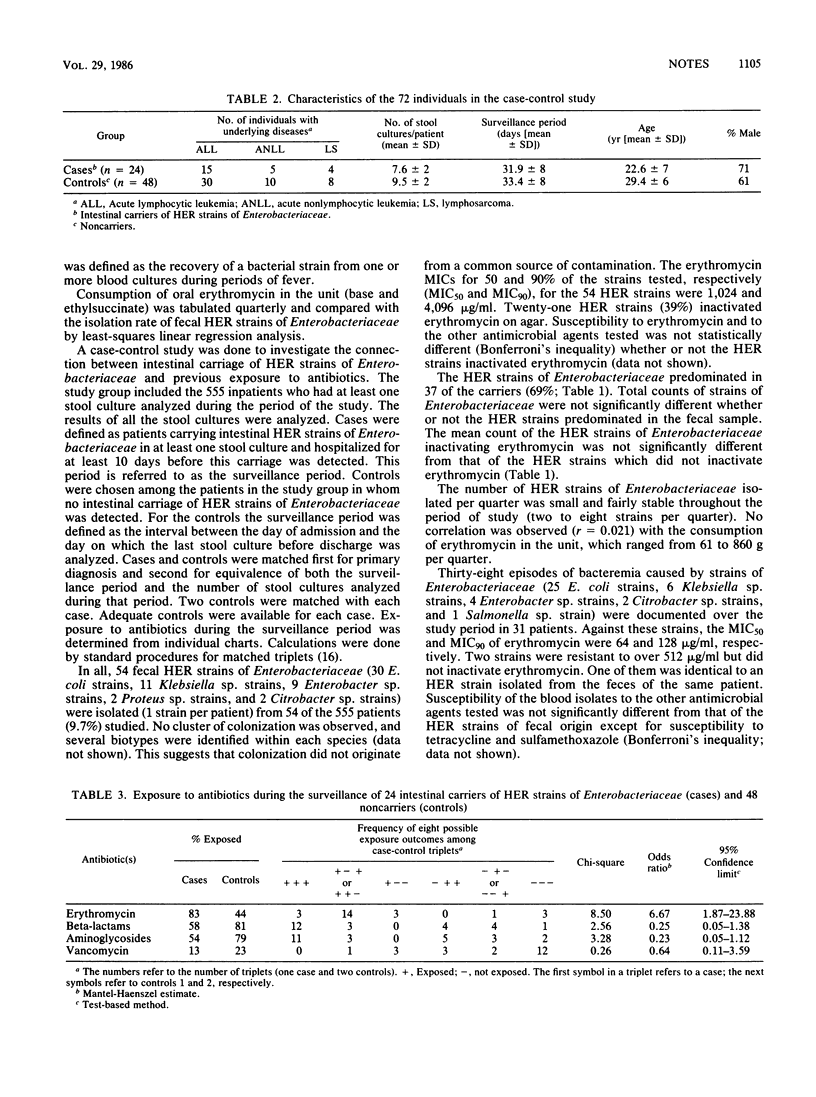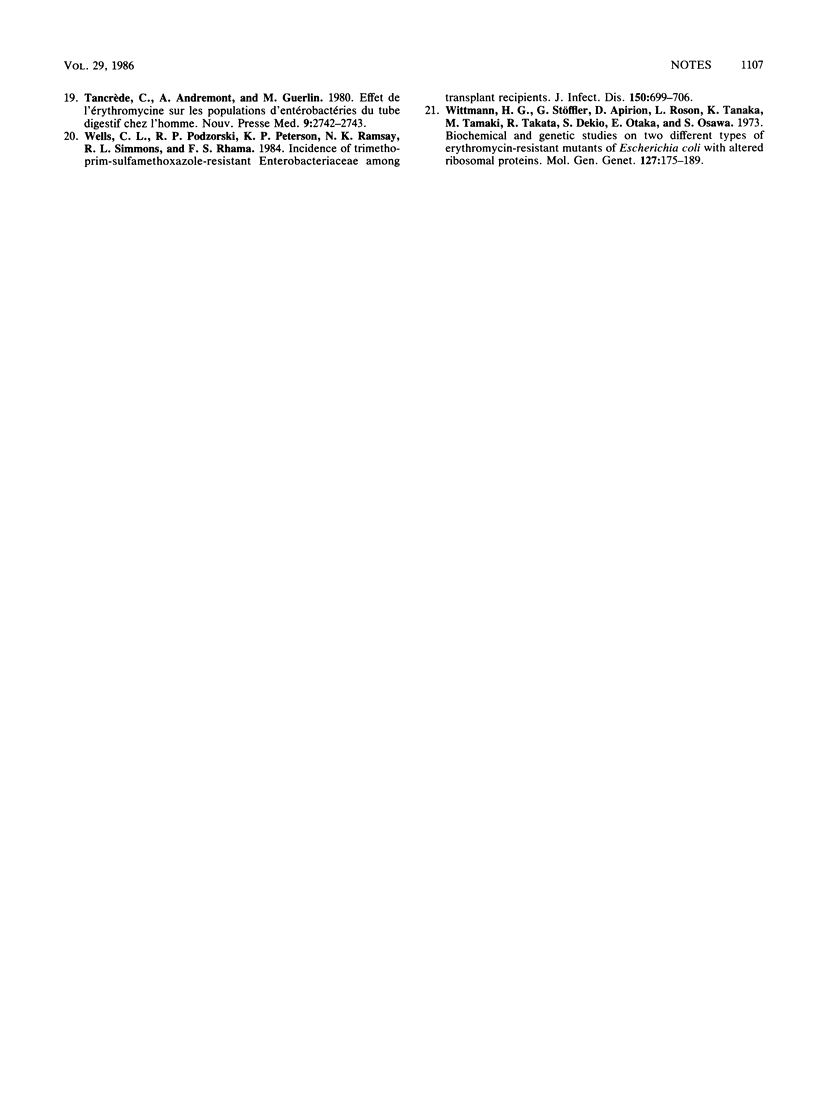Abstract
Intestinal colonization by highly erythromycin-resistant members of the family Enterobacteriaceae was surveyed for 4 years in a hematology-oncology unit. Fifty-four of 555 patients (9.7%) were colonized, each with a different strain. The incidence of intestinal carriage was not correlated with erythromycin consumption in the ward but was strongly associated with individual exposure to erythromycin.
Full text
PDF



Selected References
These references are in PubMed. This may not be the complete list of references from this article.
- Andremont A., Gerbaud G., Courvalin P. Plasmid-mediated high-level resistance to erythromycin in Escherichia coli. Antimicrob Agents Chemother. 1986 Mar;29(3):515–518. doi: 10.1128/aac.29.3.515. [DOI] [PMC free article] [PubMed] [Google Scholar]
- Andremont A., Gerbaud G., Tancrède C., Courvalin P. Plasmid-mediated susceptibility to intestinal microbial antagonisms in Escherichia coli. Infect Immun. 1985 Sep;49(3):751–755. doi: 10.1128/iai.49.3.751-755.1985. [DOI] [PMC free article] [PubMed] [Google Scholar]
- Andremont A., Raibaud P., Tancrède C. Effect of erythromycin on microbial antagonisms: a study in gnotobiotic mice associated with a human fecal flora. J Infect Dis. 1983 Sep;148(3):579–587. doi: 10.1093/infdis/148.3.579. [DOI] [PubMed] [Google Scholar]
- Andremont A., Tancrede C. Reduction of the aerobic Gram negative bacterial flora of the gastro-intestinal tract and prevention of traveller's diarrhea using oral erythromycin. Ann Microbiol (Paris) 1981 Nov-Dec;132 B(3):419–427. [PubMed] [Google Scholar]
- Barthélémy P., Autissier D., Gerbaud G., Courvalin P. Enzymic hydrolysis of erythromycin by a strain of Escherichia coli. A new mechanism of resistance. J Antibiot (Tokyo) 1984 Dec;37(12):1692–1696. doi: 10.7164/antibiotics.37.1692. [DOI] [PubMed] [Google Scholar]
- Devriese L. A., Dutta G. N. Effects of erythromycin-inactivating Lactobacillus crop flora on blood levels of erythromycin given orally to chicks. J Vet Pharmacol Ther. 1984 Mar;7(1):49–53. doi: 10.1111/j.1365-2885.1984.tb00878.x. [DOI] [PubMed] [Google Scholar]
- Eickhoff T. C., Ehret J. M. In vitro comparison of rosamicin and erythromycin against urinary tract pathogens. Antimicrob Agents Chemother. 1979 Jul;16(1):69–73. doi: 10.1128/aac.16.1.69. [DOI] [PMC free article] [PubMed] [Google Scholar]
- Goldstein F. W., Boisivon A., Leclerc P., Acar J. F. Sensibilité d'Hemophilus sp. aux antibiotiques. transfert de résistance à Escherichia coli. Pathol Biol (Paris) 1977 May;25(5):323–332. [PubMed] [Google Scholar]
- Hartley C. L., Clements H. M., Linton K. B. Effects of cephalexin, erythromycin and clindamycin on the aerobic Gram-negative faecal flora in man. J Med Microbiol. 1978 May;11(2):125–135. doi: 10.1099/00222615-11-2-125. [DOI] [PubMed] [Google Scholar]
- Heimdahl A., Nord C. E. Influence of erythromycin on the normal human flora and colonization of the oral cavity, throat and colon. Scand J Infect Dis. 1982;14(1):49–56. doi: 10.3109/inf.1982.14.issue-1.10. [DOI] [PubMed] [Google Scholar]
- Nichols R. L., Condon R. E., DiSanto A. R. Preoperative bowel preparation. Erythromycin base serum and fecal levels following oral administration. Arch Surg. 1977 Dec;112(12):1493–1496. doi: 10.1001/archsurg.1977.01370120083010. [DOI] [PubMed] [Google Scholar]
- Ounissi H., Courvalin P. Nucleotide sequence of the gene ereA encoding the erythromycin esterase in Escherichia coli. Gene. 1985;35(3):271–278. doi: 10.1016/0378-1119(85)90005-8. [DOI] [PubMed] [Google Scholar]
- Rolfe R. D., Finegold S. M. Intestinal beta-lactamase activity in ampicillin-induced, Clostridium difficile-associated ileocecitis. J Infect Dis. 1983 Feb;147(2):227–235. doi: 10.1093/infdis/147.2.227. [DOI] [PubMed] [Google Scholar]
- Tancrede C., Andremont A., Guerlin N. Effet de l'érythromycine sur les populations d'entérobactéries du tube digestif chez l'homme. Nouv Presse Med. 1980 Oct 11;9(37):2742–2743. [PubMed] [Google Scholar]
- Tancrède C. H., Andremont A. O. Bacterial translocation and gram-negative bacteremia in patients with hematological malignancies. J Infect Dis. 1985 Jul;152(1):99–103. doi: 10.1093/infdis/152.1.99. [DOI] [PubMed] [Google Scholar]
- Wells C. L., Podzorski R. P., Peterson P. K., Ramsay N. K., Simmons R. L., Rhame F. S. Incidence of trimethoprim-sulfamethoxazole-resistant enterobacteriaceae among transplant recipients. J Infect Dis. 1984 Nov;150(5):699–706. doi: 10.1093/infdis/150.5.699. [DOI] [PubMed] [Google Scholar]
- Wittmann H. G., Stöffler G., Apirion D., Rosen L., Tanaka K., Tamaki M., Takata R., Dekio S., Otaka E. Biochemical and genetic studies on two different types of erythromycin resistant mutants of Escherichia coli with altered ribosomal proteins. Mol Gen Genet. 1973 Dec 20;127(2):175–189. doi: 10.1007/BF00333665. [DOI] [PubMed] [Google Scholar]


